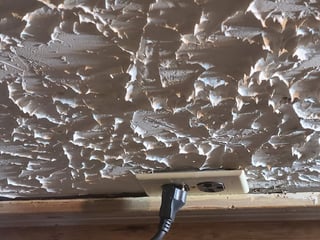I want to hang a fluorescent strip light over my workbench in the garage. The problem is that I don't see how to determine where the joists are; the ceiling is some sort of weird 3-dimensional meringue that prevents me from using a stud finder. (This area is ~12 feet from the area I'm looking at, I used this picture so that the scale of the meringue could be derived against the power outlet)
Any suggestions as to how you would do it?
Some other pictures for context (click to see full size version):
And yes, the first thing someone will say is "Where does that power conduit go in the attic?" Here it is:
The answer is, in an area of the attic with flooring blocking access. And because that wasn't enough to make my life hard, the nice insulation people threw every piece of wood they found in the attic on top of the one area I'd like to have access to:
For the record, I used a drill to probe for the joist. As it turns out, there's a gap between the ceiling and the joist, and the drill bit I used wasn't deep enough to hit the joist. As a result, I may have used more holes than was strictly necessary:
Fortunately, I went back with a long allen wrench and probed more deeply in each hole, and eventually found the joist behind one of them. Screwing in two hooks was trivial and my light is now hanging where I need it:







